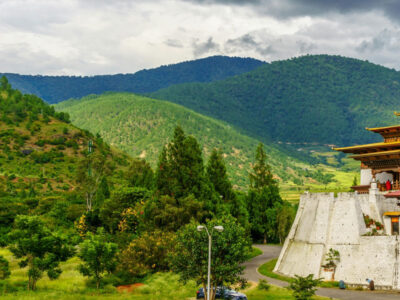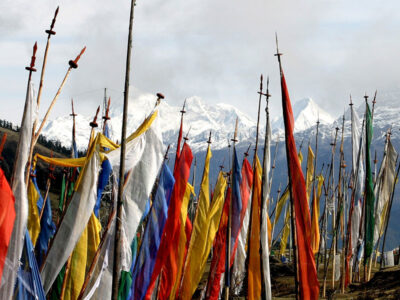Tourist Attractions
Tamshing Lhakhang:
Located across the river from Kurjey Lhakhang, this monastery was founded in 1501 by Terton Pema Lingpa, the re-incarnation of Guru Padma Sambhava. The temple houses ancient religious scrolls and paintings among which are the 1,000 Buddhas and 21 Taras or the female form of Buddhistava.
4. Jakar Dzong (Houses the administrative offices of Bumthang):
Jakar Dzong literally means the Castle of the White Bird, constructed in 1549 by the Tibetan Lama Nagi Wangchuk. The Dzong played an important role as the fortress of defense for the whole eastern part of Bhutan. It also became the seat of the first king of Bhutan. A special feature of the Dzong is the fifty meter high Utse or tower, which is distinct from most other Dzongs in Bhutan. The other unique feature of the Dzong is a sheltered passage, with two parallel walls, interconnected by fortified towers, which gave the population of the fortress access to water in the case of a siege. The protected water supply is still intact to this day.
5. Kenchosum Lhakhang:
Although built in the 6th century, this temple was renovated in 1995 and so it has a modern look to it. Legend has it that the Lhakhang contained a large bell that when it was rung, the bell could be heard all the way in Lhasa, Tibet. During the 17th century marauding Tibetan Armies tried to steal the bell but because it was too heavy, they dropped the bell and in the process cracked it. It is now on display at the National Museum in Paro.
Chamkhar Lhakhang:
This temple was first built as the palace of the Indian King Sindhu Raja. When it was first built, before the 10th century, the palace was constructed of iron – hence the name Chakhar, meaning Iron castle. In the 14th century, Dorji Lingpa, a Buddhist saint, re-built it as a place of worship.
Lhodrak Kharchhu Monastery:
This Nyingma monastery on a hilltop was founded in the 1970s by Namkhai Nyingpo Rinpoche and has more than 380 monks in residence. The new Tshokhang has massive statues of Guru Rinpoche, Chenrezig and Sakyamuni. If you’re here between 4.30 pm and 6 pm, check out the mass debating in the courtyard of the Shedra. The monks reinforce their theological arguments with a stamp of the foot and a victorious slap.
Ura Yakchoe:
Ura valley in Bumthang is known for the famous dance known as the Ura Yakchoe. The dance is performed during the May festival that is held annually. During the festival a small sacred and important relic is put on display so that the people can receive blessings. According to legend an old woman sitting outside her house was visited by a lama asking for a drink of water. When she came out with the water, the lama had vanished leaving behind only a sack. Out of curiosity, she opened the bag and found the statue that is now displayed annually. This relic has been passed down from generations and is still owned by the descendants of the woman.
Mebar Tsho – The Burning Lake:
Mebar Tsho is about 30 minutes by car from Bumthang town. It is considered to be of immense religious significance drawing in pilgrims from near and far by the hordes. The importance of the lake is obvious for visitors by the line of prayer flags and clay offerings found in everywhere along openings in rocks.
Wangdichholing Palace:
This palace was built in 1857 on the site of a battle camp of the Penlop (Governor) of Trongsa, Jigme Namgyal. It was the first palace in Bhutan that was not designed primarily as a fortress. The son of Jigme Namgyal, also First King of Bhutan, Sir Ugyen Wangchuck was born here and chose it as his principal residence. Wangduechhoeling palace was also for a time the home of the Third King, before he moved the royal court to Punakha in 1952.


